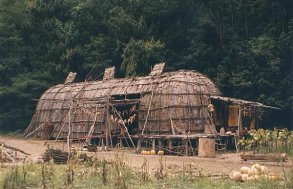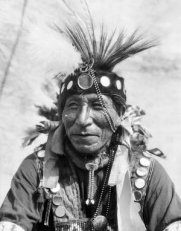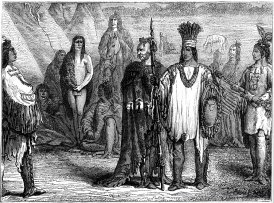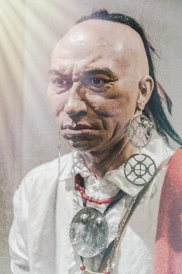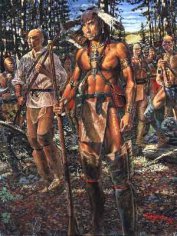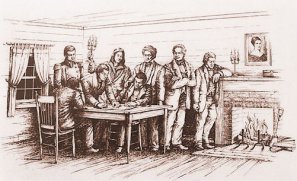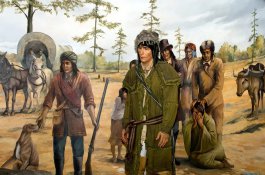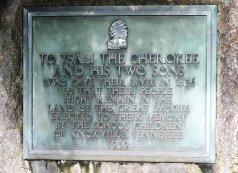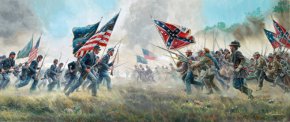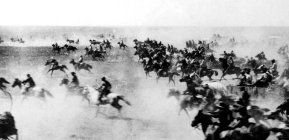Lors de la 4e saison, Claire, Jamie et Ian s’installent dans l’arrière-pays de la Caroline du Nord. À peine plantés les piquets délimitant la parcelle octroyée par le gouverneur, les Fraser se trouvent confrontés à une tribu cherokee inquiète de voir son territoire encore et toujours réquisitionné par les colons.
Le peuple cherokee, bien que n’appartenant pas aux 6 grandes nations iroquoises, en partageait cependant la langue iroquoienne, ce qui permettait des échanges entre les diverses tribus, même très éloignées.
Il vivait principalement dans les Smoky Mountains, une chaîne de montagnes de la Caroline du Nord et du Tennessee, au sud des Appalaches.
Les tribus indiennes
1 - Les Cherokees
Leurs villages, unis en une confédération très souple, étaient constitués de maisons de forme rectangulaire, vastes et aérées, recouvertes de toits à quatre pentes, faits de chaume ou de nattes de jonc tressées. Les habitations étaient entourées de petits jardins familiaux cultivés par les femmes.
Sur une terre particulièrement fertile, des champs collectifs, où chacun, même les chefs, devait travailler, assuraient l’approvisionnement de la communauté.
Ils y cultivaient le haricot, la courge, la citrouille, le tournesol, le tabac et surtout le maïs dont ils produisaient plusieurs variétés adaptées à divers usages. La chasse, la pêche, la récolte de nombreuses plantes sauvages, l’élevage du dindon, s’ajoutant à l’agriculture, leur assuraient une nourriture abondante et variée.
Durant l’été, leurs vêtements légers étaient faits de fibres végétales, remplacés en hiver par des vêtements de daim. Les dignitaires portaient durant les cérémonies des manteaux de plumes de dindon ou d’oiseaux sauvages, rappelant ceux des civilisations d’Amérique centrale
La nation cherokee était composée d'une confédération de villes "rouges" pour la guerre et "blanches" pour la paix, dont les chefs étaient subordonnés respectivement au chef de guerre suprême et au chef de paix suprême.
Le chef "blanc" appelé "Le Plus Aimé", et qui pouvait être une femme, s’occupait des affaires civiles, de la justice, des cérémonies religieuses.
Le chef "rouge" s’occupait de la guerre, ainsi que du jeu de "lacrosse", le jeu de balle répandu dans toutes les tribus de l’Est, et que l’on appelait "la petite guerre".
Une "Femme de la Guerre" accompagnait les guerriers, leur apportant assistance et conseil et décidant du sort des prisonniers.
Tandis que dans les villes blanches l'asile était offert aux malfaiteurs, dans les villes rouges avaient lieu les cérémonies de guerre.
Les Cherokees étaient divisés en sept clans, sans doute en rapport avec les sept « villes mères » de la nation cherokee ; chacune d'elles avait son chef héréditaire en ligne maternelle.
Les premiers contacts des Cherokees avec les Blancs ont lieu vers le milieu du XVIe siècle. L’Espagnol Hernando De Soto qui parcourt le Sud-Est vers 1540, très impressionné par leur richesse et le raffinement de leur culture et le nombre de leurs guerriers, n’ose les affronter.
Les Anglais recherchent l’alliance de cette puissante nation et les Cherokees comptent sur les armes qu'ils leur fournissent pour s’assurer la suprématie sur les autres nations indiennes.
En 1730, les chefs cherokees se rendent à Londres où ils signent un traité d’amitié avec la couronne britannique. Mais à partir de 1738, de terribles épidémies de variole réduisent sévèrement la population cherokee.
Ayant repris la guerre contre les Creeks, ils voient leurs villes d’Etchoe et d’Estatoe brûlées par les guerriers creeks. Ce n’est qu’en 1753 que les Cherokees font la paix avec les Creeks et reconstruisent leurs villes.
En 1758, pour se venger d’avoir été pris en otage par les colons pour une banale histoire de chevaux, le chef Oconostata lance une attaque contre les colonies anglaises, s’emparant de Fort Loudon, dans la Grande Vallée des Appalaches. Les Anglais rassemblent une armée de plusieurs milliers d’hommes et attaquent la ville d’Estatoe qu’ils détruisent complètement. Puis la ville d’Etchoe succombe à son tour, après une résistance acharnée. La prise d’Etchoe ouvre aux Blancs le cœur du pays cherokee qui est ravagé par les soldats réguliers, les milices et les Indiens alliés aux Anglais.
En 1768, puis en 1775, les Cherokees doivent accepter d’importantes cessions de territoire et tout aurait pu s'apaiser. Cependant, en juillet 1776, le jeune chef Dragging Canoe, mécontent, s'allie aux Iroquois, aux Delawares et aux Shawnees et détruit la colonie britannique d’Holston, puis tourne ses attaques contre la frontière de Caroline et de Géorgie, pendant que les milices géorgiennes détruisent les villages cherokees. Le prix du scalp cherokee monte à soixante-quinze dollars.
Une milice de deux mille hommes, avec quatre cents guerriers de la tribu Catawbas, s’enfonce dans les montagnes et réussit à s’emparer de la ville d’Estatoe qui avait été encore une fois reconstruite. Depuis Estatoe, les soldats lancent des raids contre les villages indiens. Les Cherokees pourchassés s’enfuient chez les Creeks et les Seminoles de Floride.
En 1777, les chefs demandent la paix au prix d’un nouvel abandon de terres. Dragging Canoe, qui résiste toujours avec ses mille guerriers, se retire dans les montagnes, rejoint par plusieurs centaines de Creeks, près de Chickamauga Creek. Ils seront désormais connus sous ce nom.
En avril 1779, les Chickamaugas s’allient aux Anglais contre les colons américains révoltés qui convoitent les terres indiennes. Ceux-ci se vengent en réduisant en cendres onze villages indiens, puis se lancent à l’assaut du territoire cherokee durant l’hiver et le printemps 1781 et s’installent sur les terres conquises. Les Chickamaugas poursuivent cependant la lutte dans des conditions de plus en plus difficiles, soutenus par la majorité des Cherokees.
En 1786, les Chickamaugas sont surpris dans la vallée de Coldwater Creek.
Old Tassel, le vieux chef, se rend avec un drapeau blanc. Il est assassiné. Son fils Young Tassel poursuit la lutte. En janvier, le village de Young Tassel est détruit. Dragging Canoe meurt en 1792 et Young Tassel lui succède.
En septembre 1794, le général Robertson rassemble des milliers de volontaires américains qui assiègent et détruisent un gros village chickamauga, tuant des centaines d’Indiens. La victoire du général Anthony Wayne sur une importante coalition indienne à Fallen Timbers le 20 août 1794 démoralise les Cherokees qui demandent la paix en décembre.
À partir de ce moment, la nation cherokee va prendre une autre voie. N’ayant pu résister aux assauts des Blancs et protéger son mode de vie, elle va s’engager sur "la voie de la Civilisation".
Grâce à leur travail, à leur habileté et à leur solidarité tribale, les Cherokees parviennent en une vingtaine d’années à un niveau de prospérité fort enviable. Ils fondent une capitale, New Echota, en souvenir de leur ville détruite. Beaucoup de Cherokees ont des fermes, de belles plantations qui excitent la jalousie de leurs voisins blancs.
Sequoyah invente un alphabet qui fait de la langue cherokee la première langue indienne écrite. Ils éditent un journal, le "Tsalagi Phoenix", écrit en cherokee et en anglais. Ils ont des écoles où l’on travaille dans les deux langues. Ce sont les premières écoles mixtes d’Amérique. Beaucoup de Cherokees sont devenus chrétiens. Ils ont adopté les habitations, les vêtements, le mode de vie des Blancs. La tribu compte de nombreux métis qui, pour la plupart, possèdent la richesse et ont fait des études qui leur permettent de négocier avec les Blancs. Plusieurs centaines de Blancs mariés à des Cherokees vivent parmi eux.
Les institutions de la nation cherokee sont calquées sur celles des États-Unis. Ils ont une constitution, un parlement élu, des cours de justice. La solidarité tribale traditionnelle s’est maintenue et les chefs veillent toujours à ce qu’aucun membre de la tribu ne manque du nécessaire.
En mai 1830, le président Andrew Jackson promulgue le décret de déportation des Indiens à l’ouest du Mississippi, l’"Indian Removal Act".
Une vive pression s’exerce sur les Cherokees pour qu’ils partent, surtout depuis que de l’or a été découvert sur leur territoire. L’état de Géorgie fait procéder à l’arpentage des terres cherokees qui doivent être attribuées aux colons par tirage au sort. La garde nationale de éeorgie effectue des raids de terreur dans les villages cherokees. Le président Jackson répète que la seule solution pour les Indiens est l’exil.
En mars 1831, John Ross, un métis élu chef principal de la nation, porte le conflit devant la Cour Suprême des États-Unis. En février 1832, la Cour déclare que la nation cherokee est une société distincte, ayant le droit de se gouverner elle-même, et qu’elle n’a pas à se soumettre au gouvernement américain.
Cette déclaration restera lettre morte. Les propriétés cherokees passent aux colons avec leur bétail et leurs champs cultivés. Les bâtiments publics, les écoles cherokees tombent aux mains des Blancs qui les détruisent. Un groupe de quelques milliers de métis accepte de partir vers l’Ouest en 1835. La majorité de la nation cherokee regroupée derrière John Ross va tenter de résister à la déportation.
En mai 1838, deux soldats de la garde nationale de Géorgie viennent s’emparer de Tsali, de sa femme et de ses deux fils qui vivent dans les Smoky Mountains de Caroline du Nord, menant la vie indienne traditionnelle, vivant d’agriculture et de chasse. Ils ont l'ordre de les conduire dans l’un des enclos où les Cherokees, déportés par ordre du président Andrew Jackson, attendent de prendre la route de l’exil. Comme sa femme ne marche pas assez vite au gré des soldats, l’un d’eux la frappe d’un coup de baïonnette. Indignés, Tsali et ses fils se jettent à mains nues sur les soldats. Dans la lutte, l’un d’eux est tué, probablement accidentellement, par son propre fusil, tandis que l’autre parvient à s’enfuir.
Tsali et sa famille se cachent dans une caverne des Smoky Mountains. Ils sont bientôt rejoints par trois cents Cherokees qui refusent la déportation en Territoire indien. Le général Winfield Scott fait parvenir à Tsali un message dans lequel il lui promet que si lui et ses fils se rendent, l’armée ne poursuivra pas les autres rebelles.
Quelques jours plus tard, connaissant le sort qui les attend, Tsali et ses fils se constituent prisonniers. Après un procès en cour martiale, ils sont tous les trois fusillés. L’armée tient sa promesse et les résistants cherokees pourront continuer à vivre dans leur pays. Tsali est maintenant honoré comme un martyr de la cause cherokee.
En juillet 1838, le président Jackson ordonne l’expulsion des Cherokees par la force. Ceux qui avaient gardé leurs maisons et leurs champs en sont brutalement chassés. En attendant leur départ, des milliers d’Indiens sont parqués dans des enclos dans des conditions épouvantables. Des enfants sont capturés par la garde nationale pour obliger leurs parents à se rendre.
Au début de l’automne, au nombre d’environ vingt mille, les Cherokees sont acheminés vers l’ouest par petits groupes. Avant de partir, ils embrassent les arbres qui entourent leurs demeures, comme des amis qu’ils ne reverront plus. Certains ont des chariots où l’on entasse enfants et bagages. La plupart vont à pied, poussés par les baïonnettes des soldats. Les habitants blancs des régions traversées se livrent à toutes sortes de violences sur les déportés, et les soldats ne font guère d’efforts pour les protéger. Bientôt le froid et la neige s’ajoutent à la maladie, à la faim et à l’épuisement. Les Indiens meurent par milliers le long de ce qu’ils appelleront la "Piste des Larmes". On estime qu’au moins un quart des Cherokees aura trouvé la mort pendant leur rassemblement et leur voyage vers le Territoire indien.
Un millier de Cherokees a réussi à se cacher dans les Smoky Mountains de Caroline du Nord, vivant de chasse et de cueillette. Ils obtiendront plus tard le droit de rester dans leur patrie. Leurs descendants vivent toujours sur leurs terres et ont formé la tribu des Cherokees de l’est, vivant sur la réserve de Qualla, dans les Smoky Hills.
Les Cherokees tentent de reconstituer leur vie et leur nation déchirée. Ils ont de bonnes terres dans l’est du Territoire indien. L’État américain leur a versé d’importantes indemnités qui permettent aux métis instruits et influents de restaurer leurs belles propriétés. Les plus pauvres sont assurés d’une petite ferme.
La nation cherokee reprend vie. Elle reconstitue son gouvernement, sa justice, rouvre ses écoles, reprend la publication de son journal. Ils ont une nouvelle capitale, Tahlequah, où ils organisent, en 1843, une réunion de dix-huit nations indiennes du Territoire indien et des régions voisines afin de définir une politique commune vis-à-vis du gouvernement. L’accent est mis sur la défense pacifique de la souveraineté indienne.
Les Cherokees ne profiteront hélas pas longtemps de leur tranquillité. La guerre de Sécession, commencée en 1861, leur apportera, comme aux autres nations d’Oklahoma, la mort et le malheur. De plus, ayant combattu aux côtés des Confédérés, sous le commandement du chef Stand Watie nommé général de l’armée sudiste, ils auront à subir les représailles du Nord victorieux.
Des Blancs de plus en plus nombreux s’installent sur les terres indiennes, amenés par le chemin de fer qui traverse le Territoire indien. Des mines sont ouvertes, des villes surgissent. Dans les années 1880, la pression pour une ouverture aux Blancs du Territoire indien devient irrésistible. En 1889, les terres cherokees sont réparties en lots individuels entre les membres de la tribu, en application de la loi Dawes, et ce qui reste est ouvert aux colons. C’est la première "ruée pour la terre", une course durant laquelle les colons s’efforcent de s’assurer les meilleurs lots. En 1890, le Territoire d’Oklahoma est constitué avec ces terres "ouvertes à la civilisation".
Les gouvernements cherokees et choctaws refusent l’application de la loi Dawes qui brise leur unité tribale. Le Congrès vote alors le "Curtis Act" de 1898 qui dissout les gouvernements des nations indiennes du Territoire indien, les soumettant à l’autorité des États-Unis.
La loi de Réorganisation Indienne de 1934 permet aux Cherokees de reconstituer un gouvernement autonome. Mais les territoires accaparés par les Blancs sont à jamais perdus. Les terres cherokees d’Oklahoma, qui n’ont pas le statut de réserve, sont cependant sous la protection du gouvernement fédéral.
Aujourd’hui, la population cherokee, très métissée avec des Blancs ou d’autres Indiens, atteint près de trois cent mille personnes. Certains Cherokees se sont enrichis grâce au pétrole. La majorité d'entre eux mène une vie comparable à celle de leurs voisins blancs.
S’ils ont perdu la plupart de leurs traditions ancestrales, les Cherokees sont unis par leur histoire tragique et un fort sentiment national. Tous les ans, ils donnent à Tahlequah un grand spectacle appelé "La Piste des Larmes" qui évoque le drame vécu par leurs ancêtres.
Sur leur réserve de Caroline du Nord, les descendants des Cherokees demeurés dans l’Est ont basé leur économie sur l’exploitation du bois, l’artisanat et le tourisme. Ils se sont rendus célèbres par leur "Danse de l’Aigle", une danse cérémonielle très spectaculaire qui s’est transmise de génération en génération.
Par Valérie Gay-Corajoud




